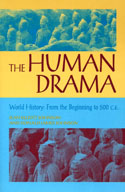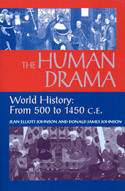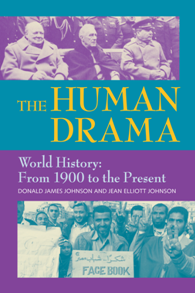In this four-part series, the authors present the development of humankind across cultures and economies, in a global manner from ancient times on, as a gigantic drama played out with the cradles of civilization as the stage. The past involves daring traders, missionaries and warriors; poets, prophets and philosophers challenging lifestyles and beliefs; inventors and artists creating world wonders and practical tools; kings and queens founding and destroying empires; citizens and slaves building the foundations for democracies. This introductory series to World History is already successfully used at America’s highly competitive and challenging Hunter College High School in New York, as well as at other elite high schools and colleges. Volumes may be ordered as a set or separately.
History of the Series:
Here is the authors’ account of how the series came about:
“The genesis of The Human Drama began in the 1980s, when Jean Johnson started teaching World History at Friends Seminary in New York City and could not find a suitable high school textbook on world history to use in her course. In the 1980s, teaching World History was just beginning to take root in colleges, and, to a lesser extent, in high schools. Jean’s course was among the first such high school course in the nation. After integrating her students’ questions and suggestions, and their ongoing research, Jean and Don Johnson produced what became Volume One of The Human Drama. Two years later, teachers at Hunter College High School, one of the most selective high schools in the city, asked if they could make copies of The Human Drama, which at this point went to about 1000 C.E., and they also introduced the books there as well. About this time Judith Zinsser, who was teaching at the UN school and later went on to teach at a university, took an interest in using The Human Drama in her classes as well.
“In the 1990s, Jean and Don Johnson began co-teaching a course on World History at New York University that was designed for students in the NYU social studies teacher education program. This was also [when] Markus Wiener began publishing the first two volumes of [the series]. The first volume … became a required text for the NYU course. Once some of the graduates of the NYU program began teaching, they introduced The Human Drama and included all four volumes as the subsequent volumes became available. Gradually, New York private schools, such as Packer, Calhoun and Berkeley Carroll, also adopted the texts. Moreover, several public high schools in Westchester County, including Scarsdale, Hastings, and Harrison, adopted the texts.
“Both Don and Jean were active in developing the National Standards for World History that [were] published in 1994. Jean especially played a major role in writing these standards and she shared her draft texts with some of the leading teachers in the world history movement. As a result, Michelle Forman, one of the teachers involved in writing the standards, who later was chosen National Teacher of the Year, wrote an endorsement for the back cover of two of the volumes. Other leaders in the world history movement also evaluated the texts during the succeeding decade.
“The final two volumes of The Human Drama were published in 2011. We believe it is important to send out information alerting teachers in both public and private schools nationwide that all four volumes of The Human Drama are available.”

Volume I: The Beginning to 500 C.E.
Chronological events are supplemented by thematic ones, such as the development of cities and trade, the spread of religions and the idea of the law, the use of technology and art, and migrations and invasions. The areas included in volume one are the Ancient Middle East, North and East Africa, Central Asia, India, China, Iran, Rome, Greece, and Meso-America.
Act 1: Origins of the Human Community until 3500 B.C.E.;
Act 2: Surplus, Specialization, and Cities in the Third Millennium B.C.E;
Act 3: Nomadic Migrations and Invasions in the Second Millennium B.C.E;
Act 4: The Axial Age from 600 to 500 B.C.E;
Act 5: Establishing a Synthesis in the Classical Age from 500 B.C.E to the start of the Common Era;
Act 6: Interacting Worlds from the Start of the Common Era to 400 C.E.
See Full Table of Contents for Volume I
Teacher’s Guide for Volume I
Click here to order the book with a 20% discount
Paperback ISBN: 1558762116 / Paperback ISBN-13: 9781558762114

Volume II: From 500 to 1450 C.E.
The second volume of the series expands upon the concepts and foundations of the first, while introducing new ideas such as complex societies, the empire, and the interplay between cultures that began to take place as the world became more interconnected. The volume also continues the pattern of establishing major concepts as “Acts” and “setting the stage” for each major era of human history.
Act 1: Complex Societies Develop in the Americas
Act 2: The Development and Spread of Universal Religions (200 B.C.E. to 800 C.E.)
Act 3: The Flowering of Empires (300 C.E. to 1200 C.E.)
Act 4: New States Emerge in Afro-Eurasia (500 to 1450)
Act 5: Hemispheric Interaction (1100 to 1450)
See Full Table of Contents for Volume II
Teachers Guide for Volume II
Click here to order Vol.II with a 20% discount
Paperback ISBN: 1558762205 / Paperback ISBN-13: 9781558762206

Volume III: From 1450 C.E. to 1900
The third volume in this highly acclaimed series examines world history from 1450 to the beginning of the twentieth century. It begins with an examination of the five newly forming “gunpowder empires” and develops the themes of industrialization and the formation of nation-states. The second half of the book covers Europe’s growing global power and concludes on the eve of the twentieth century as Europe, the United States, and Japan develop and become fully modern nations.
Act 1: Gunpowder Empires, 1450–1700
Act 2: The Development of European Nation-States and Their Worldviews, 1450–1700
Act 3: Closing the Circle and Expanding Global Interactions, 1500–1700
Act 4: The Industrial Revolution, 1770–1850
Act 5: The Era of European Colonialism, 1600–1850
Act 6: Rebellions and Revolutions, 1775–1850
Act 7: On the Road to Modernity, 1820–1914
See Full Table of Contents for Volume III
Click here to buy Vol.III with a 20% discount
Paperback ISBN: 1558762221 / Paperback ISBN-13: 9781558762220

Volume IV: From 1900 to the Present
The final volume in this highly acclaimed series ushers in the twentieth century, the bloodiest in world history, and arguably the century that saw more accelerated and profound changes than any previous era. The book begins by examining the vicious competition among nation-states for political and military dominance. It then expands its focus to consider the impact of new technological developments and artistic and philosophical ideas, including the discovery of relativity and innovative interpretations of the human mind. It concludes by discussing the lasting impact of colonialism, the rise of identity politics, and the new era of accelerated globalism.
Act 1: The World in Disorder, 1900–1940
Act 2: Colonial Nationalism, 1900–1945
Act 3: The Era of Disillusion, Depression, and War, 1920–1945
Act 4: The Cold War Era: Rebuilding and Reordering the World, 1945–1960
Act 5: Patterns of Development, 1950–1990
Act 6: A New World Order, 1989–2010
Act 7: Living in the New Global Age
See Full Table of Contents for Volume IV
Teachers’ Guide for Volume IV
Paperback ISBN: 155876223X / Paperback ISBN-13: 9781558762237
